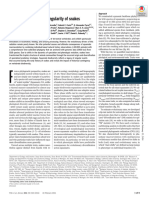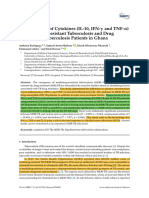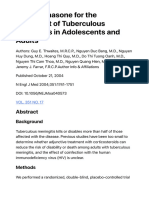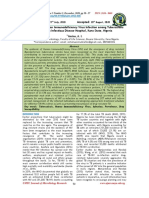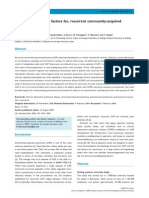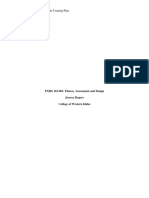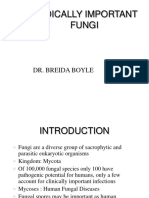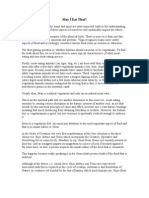Mortality Among Tuberculosis Patients in The Democratic Republic of Congo
Mortality Among Tuberculosis Patients in The Democratic Republic of Congo
Uploaded by
Gary Rios DionicioCopyright:
Available Formats
Mortality Among Tuberculosis Patients in The Democratic Republic of Congo
Mortality Among Tuberculosis Patients in The Democratic Republic of Congo
Uploaded by
Gary Rios DionicioOriginal Title
Copyright
Available Formats
Share this document
Did you find this document useful?
Is this content inappropriate?
Copyright:
Available Formats
Mortality Among Tuberculosis Patients in The Democratic Republic of Congo
Mortality Among Tuberculosis Patients in The Democratic Republic of Congo
Uploaded by
Gary Rios DionicioCopyright:
Available Formats
INT J TUBERC LUNG DIS 16(9):11991204
2012 The Union
http://dx.doi.org/10.5588/ijtld.11.0613
Mortality among tuberculosis patients in the
Democratic Republic of Congo
C. Henegar,* F. Behets,* K. Vanden Driessche,* M. Tabala, E. Bahati, V. Bola, A. Van Rie*
* Department of Epidemiology, The University of North Carolina at Chapel Hill, Chapel Hill, North Carolina, USA;
School of Public Health, University of Kinshasa, Kinshasa, National Tuberculosis Programme, Kinshasa, Democratic
Republic of Congo
SUMMARY
Kinshasa, Democratic Republic of Congo.
To identify programmatic interventions for
improved survival in patients receiving treatment for tuberculosis (TB) at primary care clinics.
D E S I G N : Retrospective cohort of adult patients initiating anti-tuberculosis treatment between January 2006
and May 2007.
R E S U LT S : Among 5685 patients, 390 deaths occurred
during anti-tuberculosis treatment, of which half (52%)
did so during the first 2 months. Patients with smearnegative pulmonary TB were at greater risk of death
in the first 2 months of treatment (human immunodeficiency virus [HIV] positive HR 1.49, 95%CI 0.89
2.49; HIV-negative HR 1.77 95%CI 1.062.95), but
not thereafter. Patients with extra-pulmonary TB were
at increased risk of death in the first 2 months of anti-
tuberculosis treatment if they were non-HIV-infected
(HR 2.42, 95%CI 1.523.85), and were half as likely to
die during the remainder of treatment (HIV-positive HR
0.46, 95%CI 0.220.97; HIV-negative HR 0.47, 95%CI
0.230.94). Antiretroviral therapy (ART) reduced the
risk of death by an estimated 36% (HR 0.64, 95%CI
0.371.11).
C O N C L U S I O N : High mortality in the first months of
anti-tuberculosis treatment could be reduced by addressing diagnostic delays, particularly for extra-pulmonary
and smear-negative TB cases and, in HIV-infected patients, by initiation of ART soon after starting antituberculosis treatment.
K E Y W O R D S : smear-negative TB; extra-pulmonary TB;
HIV
TUBERCULOSIS (TB) remains a major threat to
global public health. In 2009, 9.4 million new cases
of TB and 1.7 million deaths occurred globally.1 The
Democratic Republic of Congo (DRC) is a high TB
burden country, with an incidence rate of 372 per
100 000 population and 50 000 deaths attributed to
TB among human immunodeficiency virus (HIV) negative individuals in 2009.2 In this same year, 20% of
TB patients in the DRC who had been tested were
HIV-infected.2
High mortality rates among TB patients, particularly early in treatment, have been reported in numerous settings,35 and have been associated with diagnostic delays, which occur most frequently in the case
of smear-negative pulmonary TB and extra-pulmonary
TB (EPTB).6,7 High mortality associated with TB in
HIV-infected individuals is also well-established. TB
remains a leading cause of death among HIV-positive
individuals in sub-Saharan Africa.8,9 HIV-associated
TB is more likely to present as smear-negative pulmonary TB or EPTB.10,11
We aimed to determine mortality rates during
treatment for TB patients receiving care at primary
care clinics in Kinshasa, DRC, and to assess the independent association between death, duration of antituberculosis treatment, type of TB (smear-positive
TB, smear-negative pulmonary TB or EPTB) and HIV
status. A better understanding of factors associated
with TB mortality may lead to the identification and
prioritization of interventions needed to improve the
survival of TB patients in settings with poor health
care infrastructure.
SETTING:
OBJECTIVE:
METHODS
Study participants and data collection
Individuals aged 15 years who were diagnosed with
TB and initiated treatment at one of 14 clinics in Kinshasa between January 2006 and May 2007 were included in the analysis. Eligible clinics were those that
participated in a provider-initiated HIV counseling
and testing program for TB patients. Clinics selected
for inclusion had high patient volumes, with TB representing 30% of the overall caseload.
Correspondence to: Cassidy E Henegar, Department of Epidemiology, University of North Carolina at Chapel Hill, 2106
McGavran-Greenberg CB #7435, Chapel Hill, NC 27599, USA. Tel: (+1) 919 274 6952. Fax: (+1) 919 966 4914. e-mail:
cashene@email.unc.edu
Article submitted 4 September 2011. Final version accepted 3 April 2012.
[A version in French of this article is available from the Editorial Office in Paris and from the Union website www.theunion.org]
1200
The International Journal of Tuberculosis and Lung Disease
When a TB suspect presented to a clinic, three
separate sputum samples were taken for smear microscopy. Individuals testing positive for acid-fast bacilli on at least two smears were classified as smearpositive pulmonary TB, regardless of evidence of
extra-pulmonary involvement. Patients with more
than one negative microscopy result were started on
antibiotics for 10 days. Smear microscopy using three
sputum samples was repeated at the end of the course
of antibiotics. For individuals who were still symptomatic but had more than one negative microscopy
result, clinical management and treatment with antibiotics continued for another 1015 days before
smear microscopy was again repeated. If any two of
a total of nine smear microscopy results were positive, anti-tuberculosis treatment was initiated. If one
or none of the microscopy results was positive, the
diagnosis of smear-negative pulmonary TB or EPTB
could be made presumptively, based on clinical evaluation. Chest X-ray was used in very few (1.7%) patients, and Mycobacterium tuberculosis culture was
not available.
Individuals diagnosed with TB were treated according to the DRCs national guidelines. Patients
were treated either with 2 months of isoniazid (INH),
rifampin (RMP), ethambutol and pyrazinamide, followed by 4 months of INH and RMP, or with an extended 8-month retreatment regimen, depending on
the presence of a history of TB treatment.12 Treatment at the clinic was directly observed on a daily
basis for the first 2 months of treatment. All patients
were offered provider-initiated HIV counseling and
testing using on-site rapid tests. Outcomes were assigned to each case according to the standard World
Health Organization (WHO) definitions.12 In the
analysis, the outcome of interest was death, and all
other treatment outcomes were considered as censoring events. Patients on treatment at the end of the
data collection period were administratively right
censored, with a censoring date corresponding to the
last clinic visit.
Data analysis
Comparisons of clinical and demographic characteristics between patient groups were performed using
the Pearsons 2 tests for categorical variables, and
t-tests or the Mann-Whitney U-test for continuous
variables.
Event-free survival time was analyzed using the
Kaplan-Meier estimator. Crude incidence rates and
incidence rate ratios were calculated. Cox proportional hazards regression was used to estimate crude
and adjusted hazard ratios (HRs) and 95% confidence intervals (CIs). Retention of confounders in the
model was based on a combination of backwards
stepwise regression and a priori information.
The proportional hazards assumption was assessed
for each covariate by examining the log-log survival
plots and by testing the significance of introducing an
interaction term between exposure and time. The inclusion of time-dependent interaction terms revealed
significant interaction between time on treatment and
the HRs associated with type of TB. To account for
this, piecewise Cox proportional hazards modeling
was performed, with one model examining mortality during the first 8 weeks of treatment, and the second examining mortality during the remainder of TB
treatment.
Effect modification was assessed for individual
variables by introducing an interaction term into the
fully adjusted model between type of TB and each covariate, and comparison with a main effects model
using likelihood ratio testing (P < 0.10). The only
statistically significant pairwise interaction term was
between type of TB and HIV status. To account for
this effect modification, results are presented separately for HIV-positive and HIV-negative patients.
All analyses were performed using SAS version
9.2. (SAS Institute, Cary, NC, USA). The institutional
review boards of the University of North Carolina at
Chapel Hill and the School of Public Health, Kinshasa, approved the study.
RESULTS
Study population characteristics
Of the 5685 adult patients, 47% were female, the
mean age was 35 years, 734 (13%) had been treated
for TB in the past and most (80%) had a visible bacille Calmette-Gurin vaccination scar (Table 1).
Uptake of HIV testing was high (91.3%). Among
those tested, 18% (933) were HIV-positive. Use of
cotrimoxazole prophylaxis was also high, with 98%
(n = 846) of HIV-positive TB patients initiating
prophylaxis (Table 2). Access to antiretroviral treatment (ART) was low, with only 14% (n = 129) of
the HIV-positive patients receiving ART during antituberculosis treatment, of whom 4.9% (46/933) were
on ART at the time of TB diagnosis, and an additional
5.8% (51/877) gained access during anti-tuberculosis
treatment.
Smear-positive pulmonary TB was the most frequent diagnosis (66%, n = 3736), followed by smearnegative TB (18%, n = 1021) and EPTB (16%, n =
928). TB of the pleura (40.3%, n = 374) and lymph
nodes (37.6%, n = 349) were the most common
forms of EPTB.
Compared to those diagnosed with smear-positive
PTB, EPTB patients were less likely to have a history
of TB (6% vs. 14%, P < 0.0001), and patients with
smear-negative pulmonary or EPTB were more likely
to be older (mean age 33 vs. 40 years, P < 0.0001
and 33 vs. 38 years, P < 0.0001, respectively), or
HIV-positive (34% vs. 10%, P < 0.0001; 24% vs.
10%, P < 0.0001). HIV-positive patients were more
likely to be female (62% vs. 44%, P < 0.0001), older
TB mortality in the DRC
1201
Table 1 Socio-demographic and clinical characteristics of adult TB patients by type
of TB disease
Sex
Female
Male
Missing
Age, years
Mean
SD
HIV status
Positive
Negative
Missing
Adherence, %
80
<80
Previous TB
New case
History of TB
Missing
BCG scar
Yes
No
Missing
All
(N = 5685)
n (%)
Smear-positive PTB
(n = 3736)
n (%)
Smear-negative PTB
(n = 1021)
n (%)
2664 (46.9)
3009 (52.9)
12 (0.21)
1667 (44.6)
2061 (55.2)
8 (0.21)
34.9
13.8
32.9
12.6
933 (16.4)
4257 (74.9)
495 (8.7)
366 (9.8)
3062 (82.0)
308 (8.2)
349 (34.2)
600 (58.8)*
72 (7.1)
6214 (95.4)
301 (4.6)
3708 (95.6)
169 (4.4)
1260 (94.5)*
73 (5.5)
1246 (95.5)
59 (4.5)
4940 (86.9)
734 (12.9)
11 (0.2)
3214 (86.0)
516 (13.8)
6 (0.2)
860 (84.2)
159 (15.6)
2 (0.2)
866 (93.3)
59 (6.4)*
3 (0.3)
4546 (80.0)
982 (17.3)
157 (2.8)
3005 (80.4)
646 (17.3)
85 (2.3)
797 (78.1)
189 (18.5)
35 (3.4)
744 (80.2)
147 (15.8)
37 (4.0)
497 (48.7)
523 (51.2)*
1 (0.10)
39.7*
14.8
EPTB
(n = 928)
n (%)
500 (53.9)
425 (45.8)*
3 (0.3)
37.9*
15.3
218 (23.5)
595 (64.1)*
115 (12.4)
* P < 0.05, significantly different compared to smear-positive TB.
TB = tuberculosis; PTB = pulmonary TB; EPTB = extra-pulmonary TB; SD = standard deviation; HIV = human
immunodeficiency virus; BCG = bacille Calmette-Gurin.
Table 2 Socio-demographic and clinical characteristics
of adult TB patients by HIV status
HIV-positive
(n = 933)
n (%)
Age, years
Mean
SD
Sex
Female
Male
Missing
Adherence, %
80
<80
Previous TB disease
New case
Prior TB treatment
Missing
BCG-vaccinated
Yes
No
Missing
Cotrimoxazole use
Started before TB treatment
Started during TB treatment
Started, no date
Not started
Antiretroviral use
Started before TB treatment
Started during TB treatment
Started, no date
Not started
38.1
9.7
HIV-negative
(n = 4257)
n (%)
34.2+
14.5
579 (62.1)
353 (37.8)
1 (0.1)
1873 (44.0)*
2376 (55.8)
8 (0.2)
878 (94.1)
55 (5.9)
4053 (95.2)
204 (4.8)
750 (80.4)
179 (19.2)
4 (0.4)
3752 (88.1)*
498 (11.7)
7 (0.2)
748 (80.2)
156 (16.7)
29 (3.1)
3399 (79.8)
737 (17.3)
121 (2.8)
79 (8.5)
766 (82.1)
66 (7.1)
22 (2.4)
46 (4.9)
51 (5.5)
32 (3.4)
804 (86.2)
* P < 0.05; significantly different compared to HIV-positive.
TB = tuberculosis; HIV = human immunodeficiency virus; SD = standard
deviation; BCG = bacille Calmette-Gurin.
(mean age 38 vs. 34 years, P < 0.0001), and have a
history of treatment for TB (19% vs. 12%, P <
0.0001) compared to HIV-negative TB patients.
Factors associated with TB mortality
During 38 390 patient-months of observation, 390
deaths occurred, corresponding to a mortality rate of
0.01 deaths per person-month. The Kaplan-Meier estimate of survival at 8 months of treatment was 92.6%.
Death was most common early in anti-tuberculosis
treatment, with 8% (n = 31) of all deaths occurring
in the first week after treatment initiation and 52%
(n = 201) in the first 2 months of treatment.
Overall, death occurred after a median of 59 days
(interquartile range [IQR] 27108) of treatment. Median time to death was shorter for EPTB (42 days,
IQR 765) than for smear-negative PTB (58 days, IQR
26109) and smear-positive PTB cases (63 days, IQR
39118). For EPTB cases, median time to death was
longer for cases with cervical lymph node (42 days,
IQR 25118) and pleural TB (44 days, IQR 1768)
compared to abdominal (12 days, IQR 625) and
pericardial TB (19 days, IQR 830).
Mortality was higher in patients with a history of
prior anti-tuberculosis treatment (incidence rate ratio [IRR] 1.45, 95%CI 1.121.87) than among new
TB cases. Mortality was also higher for both smearnegative pulmonary TB (IRR 1.90, 95%CI 1.51
2.40) and EPTB (IRR 1.45, 95%CI 1.101.89) compared to smear-positive TB (Table 3). The strongest
1202
The International Journal of Tuberculosis and Lung Disease
Table 3 Mortality by socio-demographic and clinical
patient characteristics
Total
Deaths number
n
of patients
Sex
Male
Female
Mean age, years
35
>35
History of TB
New case
History of TB
BCG vaccination
Vaccination scar
No vaccination scar
Type of TB
Smear-positive
Smear-negative
Extra-pulmonary TB
HIV status
HIV-negative
HIV-positive
Cotrimoxazole use
Never started
Started before or during
TB treatment
Antiretroviral therapy
Never started
Started treatment before
or during TB treatment
IRR (95%CI)
for mortality
207
182
2684
2435
1.0
0.99 (0.811.20)
172
218
3021
2109
1.0
1.92 (1.572.35)
320
70
4457
662
1.0
1.45 (1.121.87)
300
73
4100
883
1.0
0.88 (0.681.13)
212
106
72
3338
930
862
1.0
1.90 (1.512.40)
1.45 (1.101.89)
145
204
848
3810
1.0
3.56 (2.884.41)
12
142
836
0.98 (0.313.08)
131
721
1.0
14
127
0.63 (0.361.10)
1.0
IRR = incidence rate ratio; CI = confidence interval; TB = tuberculosis; BCG =
bacille Calmette-Gurin; HIV = human immunodeficiency virus.
Table 4 Crude and adjusted hazard ratios for mortality
according to form of TB disease, stratified by HIV status and
treatment phase
Relative hazard
Clinical characteristics
HIV-negative
Intensive phase
PTB smear-positive
PTB smear-negative
EPTB
Continuation phase
PTB smear-positive
PTB smear-negative
EPTB
HIV-positive
Intensive phase
PTB smear-positive
PTB smear-negative
EPTB
Continuation phase
PTB smear-positive
PTB smear-negative
EPTB
Crude (95%CI)
Adjusted (95%CI)*
1.0
2.14 (1.303.52)
2.85 (1.814.48)
1.0
1.77 (1.062.95)
2.42 (1.523.85)
1.0
1.33 (0.822.24)
0.57 (0.281.19)
1.0
0.98 (0.581.65)
0.46 (0.220.97)
1.0
1.56 (0.942.60)
0.64 (0.441.67)
1.0
1.49 (0.892.49)
0.85 (0.441.67)
1.0
0.86 (0.521.43)
0.47 (0.240.96)
1.0
0.86 (0.521.44)
0.47 (0.230.94)
* Adjusted for sex and age.
TB = tuberculosis; HIV = human immunodeficiency virus; CI = confidence
interval; PTB = pulmonary TB; EPTB = extra-pulmonary TB.
risk of death in the first months of treatment of HIVpositive individuals with EPTB did not increase (aHR
0.85, 95%CI 0.441.67).
DISCUSSION
risk factor for mortality was HIV infection (IRR 3.6,
95%CI 2.94.4). Access to ART resulted in an estimated 37% reduction in risk of death (IRR 0.63,
95%CI 0.361.10). Cotrimoxazole prophylaxis did
not appear to have a protective effect during antituberculosis treatment (IRR 0.98, 95%CI 0.313.08).
To estimate the independent effects of HIV status,
type of TB and duration of TB treatment on mortality, we used multivariate Cox proportional hazards
models adjusting for confounders (Table 4). Among
HIV-negative individuals, smear-negative pulmonary
TB was associated with an increased hazard of death
(adjusted hazard ratio [aHR] 1.77, 95%CI 1.06
2.95) during the first 2 months of anti-tuberculosis
treatment, but not thereafter (aHR 0.98, 95%CI
0.581.65). EPTB was associated with a greater than
two-fold increased hazard of death (aHR 2.42, 95%CI
1.523.85) in the first 2 months of treatment, and a
50% reduction in risk of death thereafter (aHR 0.46,
95%CI 0.220.97). Similar to our observation in
HIV-negative patients, smear-negative pulmonary TB
also increased the risk of death during the first months
of treatment (aHR 1.49, 95%CI 0.892.49), but not
thereafter (aHR 0.86, 95%CI 0.521.44), and EPTB
was associated with a lower hazard of death after the
first 2 months of treatment (aHR 0.47, 95%CI 0.23
0.94). In contrast to HIV-negative individuals, the
In a cohort of TB patients diagnosed and treated at
primary health care clinics in Kinshasa, DRC, the risk
of death during anti-tuberculosis treatment was independently associated with type of TB, duration of
treatment, and HIV status, with an increased risk of
death in the first months of treatment among patients
with smear-negative pulmonary TB and EPTB, and
among HIV-positive patients.
Mortality was highest in the first months of treatment in both HIV-positive and -negative patients. High
rates of early death among HIV-positive patients have
been described in numerous settings, and to a lesser
extent in HIV-negative individuals.4,5,13
HIV-positive patients were at increased risk of
death, regardless of type of TB, as has been observed
in numerous other studies.4,1416 Given the low levels
of access to ART in the DRC, the majority of HIVpositive patients most likely had moderate to advanced immune suppression at the time of TB diagnosis. Degree of immune suppression could not be
addressed in our cohort, as CD4 assessment was not
available in this setting. ART has been shown to drastically improve survival in HIV-positive TB patients.17,18 We observed that, for those on ART, the
risk of mortality was reduced by an estimated 36%.
Randomized controlled trials recently demonstrated
reductions in mortality associated with starting ART
TB mortality in the DRC
soon after the start of anti-tuberculosis treatment.19
Cotrimoxazole preventive therapy given in conjunction with TB treatment has also been shown to reduce
overall mortality during treatment for HIV-positive
patients.20 This protective effect was not observed in
our cohort, possibly due to the small number (2%) of
HIV-positive patients not receiving cotrimoxazole.
Increased risks of death associated with smearnegative pulmonary TB and EPTB have been reported
in various settings.14,21,22 We expanded on this knowledge by demonstrating that the effect of type of TB
on mortality is modified by duration of treatment
and HIV status. Smear-negative pulmonary TB only
increased the risk of mortality early in treatment,
while EPTB increased the risk of death early in treatment only in HIV-negative individuals, and was associated with a 50% lower risk of death after the first
months of treatment, independently of HIV status.
As in other resource-poor settings, delays in diagnosis
of smear-negative TB and EPTB in our cohort likely
contributed to the high death rates observed among
these patients.7,23
From the clinical data available, we were unable to
assess the duration of the diagnostic process for those
with different forms of TB. The diagnostic algorithms
used in the clinics for EPTB and smear-negative TB,
however, were more extended and complex. Antituberculosis treatment was initiated only after an official diagnosis of TB was made, meaning that, in
general, smear-positive cases were started on treatment sooner after presenting for evaluation than patients with other forms of the disease.
The lower risk of death among patients with EPTB
after 2 months of treatment could be due to a surviving cohort effect. Patients with severe forms of EPTB,
such as TB meningitis and abdominal TB, are at high
risk of death. In our cohort, time to death was shorter
for patients with abdominal TB and pericardial TB
compared to patients with milder forms of EPTB, cervical lymph node and pleural TB. Only five cases of
TB meningitis were seen at the clinic, and it is likely
that individuals with this severe form of TB disease
reported directly to a hospital rather than to a primary care clinic for treatment.
Although observational research is important, as
it studies the real-world setting in which patients receive care, it often suffers from important inherent
limitations. The lack of resources that determined
the care patients received may have led to misclassification. In our cohort, 35% of patients did not have
microbiologically confirmed TB, and the presence of
drug-resistant TB could not be evaluated. In the absence of diagnostics other than smear microscopy, it
is common for other conditions to be misclassified as
smear-negative or extra-pulmonary disease, or for
other underlying conditions to be missed.24,25 Misdiagnosis and treatment for TB in patients with conditions other than TB could have contributed to the
1203
high rates of early mortality in our cohort. Similar to
most studies of mortality of TB, the cause of death
could not be established in our cohort. An autopsy
study in Thailand revealed that only 27% of the TB
patients who died during treatment died of TB. In addition, 16% of patients who were assumed to have
died from TB did not even have TB.26 In sub-Saharan
Africa, the higher mortality in patients with smearnegative pulmonary TB and EPTB has been attributed
to misdiagnosis of HIV-related diseases as TB.24
In conclusion, we identified higher mortality rates
in HIV-positive patients, increased risk of death among
patients with smear-negative PTB and EPTB in the
first months of treatment for HIV-negative patients,
and lower risk of death among EPTB cases who survive the first 2 months of treatment. Diagnostic delay due to reliance on smear microscopy and clinical
judgment, as well as lack of access to ART, were likely
the most important factors contributing to the excess
mortality seen in these patients. Improving TB diagnosis by using rapid point-of-care diagnostics such as
Xpert MTB/RIF (Cepheid, Sunnyvale, CA, USA, an
assay with improved sensitivity for diagnosis of smearnegative TB and the ability to differentiate between
drug-susceptible and drug-resistant TB), and when
CD4 count is not easily accessible, initiating ART independently of CD4 count soon after the start of
anti-tuberculosis treatment, are two interventions recently recommended by the WHO that could lead to
important reductions in mortality among individuals
seeking TB care at primary health facilities.27,28
References
1 World Health Organization. Global tuberculosis control: WHO
report 2010. WHO/HTM/TB/2010. Geneva, Switzerland: WHO,
2010.
2 World Health Organization. Tuberculosis profile: Democratic
Republic of the Congo. Geneva, Switzerland: WHO, 2010.
3 Harries A D, Hargreaves N J, Gausi F, Kwanjana J H, Salaniponi F M. High early death rate in tuberculosis patients in Malawi. Int J Tuberc Lung Dis 2001; 5: 10001005.
4 Connolly C, Davies G R, Wilkinson D. Impact of the human
immunodeficiency virus epidemic on mortality among adults
with tuberculosis in rural South Africa, 19911995. Int J Tuberc
Lung Dis 1998; 2: 919925.
5 Nunn P, Brindle R, Carpenter L, et al. Cohort study of human
immunodeficiency virus infection in patients with tuberculosis
in Nairobi, Kenya. Am Rev Respir Dis 1992; 146: 849854.
6 Storla D G, Yimer S, Gunnar A B. A systematic review of delay
in the diagnosis and treatment of tuberculosis. BMC Public
Health 2008; 8: 15.
7 Whitehorn J, Ayles H, Godfrey-Faussett P. Extra-pulmonary
and smear-negative forms of tuberculosis are associated with
treatment delay and hospitalisation. Int J Tuberc Lung Dis
2010; 14: 741744.
8 Cantwell M F, Binkin N J. Impact of HIV on tuberculosis in
sub-Saharan Africa: a regional perspective. Int J Tuberc Lung
Dis 1997; 1: 205214.
9 Corbett E L, Watt C J, Walker N, et al. The growing burden of
tuberculosis: global trends and interactions with the HIV epidemic. Arch Intern Med 2003; 163: 10091021.
10 Havlir D V, Barnes P F. Tuberculosis in patients with human
1204
11
12
13
14
15
16
17
18
19
The International Journal of Tuberculosis and Lung Disease
immunodeficiency virus infection. N Engl J Med 1999; 340:
367373.
De Cock K M, Soro B, Coulibaly I M, Lucas S B. Tuberculosis
and HIV infection in sub-Saharan Africa. JAMA 1992; 268:
15811587.
World Health Organization. Treatment of tuberculosis guidelines. 3rd ed. WHO/CDS/TB2003.313. Geneva, Switzerland:
WHO, 2003.
Kyeyune R, den Boon S, Cattamanchi A, et al. Causes of early
mortality in HIV-infected TB suspects in an East African referral hospital. J Acquir Immune Defic Syndr 2010; 55: 446450.
Harries A, Nyangulu D, Kangombe C, et al. Treatment outcome of an unselected cohort of tuberculosis patients in relation to human immunodeficiency virus serostatus in Zomba
hospital, Malawi. Trans Roy Soc Trop Med Hyg 1998; 92:
343347.
Kwara A, Roahen-Harrison S, Prystowsky E, et al. Manifestations and outcome of extra-pulmonary tuberculosis: impact of
human immunodeficiency virus co-infection. Int J Tuberc Lung
Dis 2005; 9: 485493.
Ackah A N, Digbeu H, Daillo K, et al. Response to treatment,
mortality and CD4 lymphocyte counts in HIV-infected persons
with tuberculosis in Abidjan, Cote dIvoire. Lancet 1995; 345:
607610.
Mugusi F M, Mehta S, Villamor E, et al. Factors associated
with mortality in HIV-infected and non-infected patients with
pulmonary tuberculosis. BMC Public Health 2009; 9: 409.
Akkslip S, Karnkawinpong O, Wattanaamornkiat W, et al. Antiretroviral therapy during tuberculosis treatment and marked
reduction in death rate of HIV-infected patients, Thailand.
Emerg Infect Dis 2007; 13: 10011007.
Moore D, Liechty C, Ekwaru R, et al. Prevalence, incidence
and mortality associated with tuberculosis in HIV-infected pa-
20
21
22
23
24
25
26
27
28
tients initiating antiretroviral therapy in rural Uganda. AIDS
2007; 21: 713719.
Karim S, Naidoo K, Grobler A, et al. Timing of initiation of
antiretroviral drugs during tuberculosis therapy. N Engl J Med
2010; 362: 697706.
Nunn A J, Mwaba P, Chintu C, Mwinga A, Darbyshire J,
Zumla A. Role of co-trimoxazole prophylaxis in reducing mortality in HIV-infected adults being treated for tuberculosis:
randomized clinical trial. BMJ 2008; 337: a257.
Getahun H, Harrington M, OBrien R, Nunn P. Diagnosis of
smear-negative pulmonary tuberculosis in people with HIV infection or AIDS in resource-constrained settings: urgent policy
changes. Lancet 2007; 369: 20422049.
Kangombe C T, Harries A D, Ito K, et al. Long-term outcome
in patients registered with tuberculosis in Zomba, Malawi:
mortality at 7 years according to initial HIV status and type of
TB. Int J Tuberc Lung Dis 2004; 8: 829836.
Cain K, Thanomsak A, Channawong B, et al. Causes of death
in HIV-infected persons who have tuberculosis, Thailand.
Emerg Infect Dis 2009; 15: 258264.
Mukadi Y, Maher D, Harries A. Tuberculosis case fatality rates
in high HIV prevalence populations in sub-Saharan Africa.
AIDS 2001; 15: 143152.
Lorent N, Mugwaneza P, Mugabekazi J, et al. Risk factors for
delay in the diagnosis and treatment of tuberculosis at a referral
hospital in Rwanda. Int J Tuberc Lung Dis 2008; 12: 392396.
World Health Organization. Press release: WHO endorses new
rapid tuberculosis test. December 8, 2010. Geneva, Switzerland:
WHO, 2010. http://www.who.int/mediacentre/news/releases/
2010/tb_test_20101208/en/index.html Accessed May 2012.
World Health Organization. Rapid advice: antiretroviral therapy for HIV infection in adults and adolescents. Geneva, Switzerland: WHO, 2009.
TB mortality in the DRC
RSUM
CONTEXTE :
Kinshasa, Rpublique dmocratique du
Congo.
O B J E C T I F : Identifier les interventions programmatiques
pour amliorer la survie chez les patients sous traitement
pour tuberculose (TB) dans les dispensaires de soins
primaires.
S C H M A : Cohorte rtrospective de patients adultes
commenant un traitement antituberculeux entre janvier 2006 et mai 2007.
R S U LTAT S : Sur 5685 patients, on a vu survenir 390
dcs au cours du traitement de la TB, dont la moiti
(52%) au cours des 2 premiers mois. Les risques de
dcs au cours des 2 premiers mois du traitement sont
plus levs chez les patients atteints de TB pulmonaire
bacilloscopie ngative (virus de limmunodficience humaine [VIH] positif HR 1,49 ; IC95% 0,892,49 ; VIH
ngatif HR 1,77 ; IC95% 1,062,95), mais il nen na
pas t ainsi dans les mois suivants. Chez les patients atteints dune TB extrapulmonaire, le risque de dcs est
accru au cours des 2 premiers mois du traitement TB
chez les sujets non-infects par le VIH (HR 2,42 ; IC95%
1,523,85), et le risque de dcs est rduit de moiti au
cours du reste du traitement TB (VIH positif HR 0,46 ;
IC95% 0,220,97 ; VIH ngatif HR 0,47 ; IC95% 0,23
0,94). Le risque de dcs est dcru par le traitement antirtroviral (ART) denviron 36% (HR 0,64 ; IC95%
0,371,11).
C O N C L U S I O N : Une mortalit leve au cours des premiers mois du traitement TB pourrait tre rduite en
soccupant des retards de diagnostic, particulirement
pour les cas de TB extrapulmonaire et bacilloscopie
ngative ainsi que par la mise en route de lART rapidement aprs la mise en route du traitement TB chez les
patients infects par le VIH.
RESUMEN
Kinshasa, en la Repblica
Democrtica del Congo.
O B J E T I V O : Revelar las intervenciones programticas
que mejoran la supervivencia de los pacientes que reciben tratamiento antituberculoso en los consultorios de
atencin primaria.
M T O D O : Se llev a cabo un estudio retrospectivo de
cohortes de adultos que iniciaron el tratamiento antituberculoso entre enero del 2006 y mayo del 2007.
R E S U LTA D O S : En los 5685 pacientes que participaron
se observaron 390 muertes durante el tratamiento antituberculoso, de las cuales la mitad (52%) ocurri durante los primeros 2 meses. Los pacientes con TB pulmonar y baciloscopia negativa presentaron un mayor
riesgo de muerte en este perodo del tratamiento, pero
no as ms tarde (en los pacientes positivos frente al virus de la inmunodeficiencia humana [VIH] HR 1,49;
IC95% 0,89 a 2,49; en los pacientes seronegativos para
MARCO DE REFERENCIA:
el VIH HR 1,77; IC95% 1,06 a 2,95). En los casos de
TB extrapulmonar, los pacientes presentaron un mayor
riesgo de muerte durante los 2 primeros meses cuando
eran negativos para el VIH (HR 2,42; IC95% 1,52 a
3,85) y 50% de probabilidad de morir durante el resto
del tratamiento (VIH positivos HR 0,46; IC95% 0,22 a
0,97; VIH negativos HR 0,47; IC95% 0,23 a 0,94). El
tratamiento antirretrovrico (ART) disminuy el riesgo
de muerte un 36% (HR 0,64; IC95% 0,37 a 1,11).
C O N C L U S I N : Es necesario disminuir la alta mortalidad que se observa durante los primeros meses del tratamiento antituberculoso, mediante la correccin de los
retrasos del diagnstico, sobre todo en los casos de TB
extrapulmonar y de baciloscopia negativa y con la iniciacin del ART tan pronto como se d comienzo al tratamiento antituberculoso en los pacientes infectados por
el VIH.
You might also like
- Macroevolution SnakesDocument6 pagesMacroevolution SnakesLucas PedrottiNo ratings yet
- Ark Artifact Item ID List - Ark IDsDocument11 pagesArk Artifact Item ID List - Ark IDsozon nihonNo ratings yet
- AntiviralsDocument21 pagesAntiviralsRex Karl TeoxonNo ratings yet
- Mink Dissection InstructionsDocument15 pagesMink Dissection InstructionsMark PenticuffNo ratings yet
- Survey of The Brony Subculture, 2nd Ed.Document27 pagesSurvey of The Brony Subculture, 2nd Ed.opspe100% (1)
- Smoking Increases Risk of Recurrence After Successful Anti-Tuberculosis TreatmentDocument8 pagesSmoking Increases Risk of Recurrence After Successful Anti-Tuberculosis TreatmentRaditya Imam PratanaNo ratings yet
- Servikal TBDocument15 pagesServikal TBnur wahidaNo ratings yet
- Which Patients Are Able To Adhere To Tuberculosis Treatment? A Study in A Rural Area in The Northwest Part of TurkeyDocument7 pagesWhich Patients Are Able To Adhere To Tuberculosis Treatment? A Study in A Rural Area in The Northwest Part of TurkeyAnonymous QPXAgjBwNo ratings yet
- Basingnaa-Cytokine in DR TBDocument10 pagesBasingnaa-Cytokine in DR TBHatif ChanifahNo ratings yet
- Arentz Et AlDocument8 pagesArentz Et Alkang.asep008No ratings yet
- Outcome and Clinical Characteristics in Pleural Empyema: A Retrospective StudyDocument7 pagesOutcome and Clinical Characteristics in Pleural Empyema: A Retrospective StudylestarisurabayaNo ratings yet
- The Burden of Bacteriologically Negative TB DiagnosisDocument9 pagesThe Burden of Bacteriologically Negative TB DiagnosisMeiyanti MeiyantiNo ratings yet
- Long-Term Outcome of Smear-Positive Tuberculosis Patients After Initiation and Completion of Treatment A Ten-Year Retrospective Cohort StudyDocument16 pagesLong-Term Outcome of Smear-Positive Tuberculosis Patients After Initiation and Completion of Treatment A Ten-Year Retrospective Cohort StudyDanielNo ratings yet
- Diagnosis & Treatment of Tuberculosis in HIV Co-Infected PatientsDocument16 pagesDiagnosis & Treatment of Tuberculosis in HIV Co-Infected PatientsdevisilalahiNo ratings yet
- Jurnal Reading IDocument9 pagesJurnal Reading IDwi Andrio SeptadiNo ratings yet
- Survival Status and Treatment Outcome ofDocument6 pagesSurvival Status and Treatment Outcome ofEghar EverydayishellNo ratings yet
- Research Article: Characteristics and Treatment Outcomes of Retreatment Tuberculosis Patients in BeninDocument7 pagesResearch Article: Characteristics and Treatment Outcomes of Retreatment Tuberculosis Patients in BeninfaustinaNo ratings yet
- CAP - PrinaDocument12 pagesCAP - PrinaSalNo ratings yet
- Jurnal PPT Oom111Document14 pagesJurnal PPT Oom111shanazNo ratings yet
- Review Afb Neg CultureDocument7 pagesReview Afb Neg Cultureธิรดา สายสตรอง สายจำปาNo ratings yet
- Long Walk TBDocument3 pagesLong Walk TBdellanurainiNo ratings yet
- 2017 Article 2662Document11 pages2017 Article 2662Dhani KurniawanNo ratings yet
- Hiv/Tb: When Is It Safe To Start Haart?: DebateDocument5 pagesHiv/Tb: When Is It Safe To Start Haart?: DebateasayeyordanosNo ratings yet
- IJTLDeditorial Protecting HCworkers Form TBDocument2 pagesIJTLDeditorial Protecting HCworkers Form TBRoma ParyaniNo ratings yet
- Survival of Smear-Positive Multidrug Resistant Tuberculosis Patients in Witbank, South Africa: A Retrospective Cohort StudyDocument18 pagesSurvival of Smear-Positive Multidrug Resistant Tuberculosis Patients in Witbank, South Africa: A Retrospective Cohort Studyevi novalitaNo ratings yet
- Tropical Med Int Health - 2005 - Boeree - Efficacy and Safety of Two Dosages of Cotrimoxazole As Preventive Treatment ForDocument11 pagesTropical Med Int Health - 2005 - Boeree - Efficacy and Safety of Two Dosages of Cotrimoxazole As Preventive Treatment Forbk regulatoryNo ratings yet
- Factors Contributing To Poor Compliance With Anti-Tb Treatment Among Tuberculosis PatientsDocument14 pagesFactors Contributing To Poor Compliance With Anti-Tb Treatment Among Tuberculosis PatientsAnonymous QPXAgjBwNo ratings yet
- Jurnal TBC Inter 1Document5 pagesJurnal TBC Inter 1sekti lindaNo ratings yet
- Mortality in Successfully Treated Tuberculosis Patients in Southern Ethiopia Retrospective Follow Up StudyDocument6 pagesMortality in Successfully Treated Tuberculosis Patients in Southern Ethiopia Retrospective Follow Up StudyDanielNo ratings yet
- Dexamethasone For The Treatment of Tuberculous Meningitis in Adolescents and Adults - New England Journal of MedicineDocument27 pagesDexamethasone For The Treatment of Tuberculous Meningitis in Adolescents and Adults - New England Journal of Medicinenq6ws995y2No ratings yet
- Poster Discussion Room C1c - 10:45-12:45Document5 pagesPoster Discussion Room C1c - 10:45-12:45aderina9032No ratings yet
- TB and HIVDocument62 pagesTB and HIVNational Press FoundationNo ratings yet
- (2020) Treatment Outcome of Tuberculosis Treatment Regimens in Kandahar, AfghanistanDocument7 pages(2020) Treatment Outcome of Tuberculosis Treatment Regimens in Kandahar, AfghanistanBilal Ahmad RahimiNo ratings yet
- Clin Infect Dis. 1999 Nüesch 1519 23Document5 pagesClin Infect Dis. 1999 Nüesch 1519 23yeni62No ratings yet
- 120-Article Text-205-1-10-20190820Document5 pages120-Article Text-205-1-10-20190820Tayyaba RahatNo ratings yet
- Improving Survival With TBDocument8 pagesImproving Survival With TBdani catriaNo ratings yet
- TBC and VihDocument12 pagesTBC and VihCynthia O. CórdovaNo ratings yet
- Neuromeningeal Tuberculosis at The Brazzaville University Hospital Prevalence and Associated FactorsDocument5 pagesNeuromeningeal Tuberculosis at The Brazzaville University Hospital Prevalence and Associated FactorsScivision PublishersNo ratings yet
- Adverse Drug Reactions of Primary Anti-Tuberculosis Drugs Among Tuberculosis Patients Treated in Chest ClinicDocument8 pagesAdverse Drug Reactions of Primary Anti-Tuberculosis Drugs Among Tuberculosis Patients Treated in Chest ClinicSelina WijayaNo ratings yet
- Nihms 822807Document15 pagesNihms 822807Novita maraNo ratings yet
- Incidence Predictors Poor Outcome Childhood TB North Cameroun ADB 1Document15 pagesIncidence Predictors Poor Outcome Childhood TB North Cameroun ADB 1Elie Junior Olomo NdjambouNo ratings yet
- Epidemiological Clinical Evolutive and Prognostic Aspects of Tuberculosis Hiv Coinfection in The Gbeke Region in Cte DivoireDocument5 pagesEpidemiological Clinical Evolutive and Prognostic Aspects of Tuberculosis Hiv Coinfection in The Gbeke Region in Cte DivoireScivision PublishersNo ratings yet
- Prevalence of Human Immunodeficiency Virus Infection Among Tuberculosis Patients at Infectious Disease Hospital, Kano State, NigeriaDocument8 pagesPrevalence of Human Immunodeficiency Virus Infection Among Tuberculosis Patients at Infectious Disease Hospital, Kano State, NigeriaUMYU Journal of Microbiology Research (UJMR)No ratings yet
- Wen 2018 Et AlDocument12 pagesWen 2018 Et Alkang.asep008No ratings yet
- Pulmonary Impairment After Tuberculosis : Original ResearchDocument8 pagesPulmonary Impairment After Tuberculosis : Original ResearchPalaniappan MeyyappanNo ratings yet
- Title Subtle Presentation of Cryptic Tuberculosis in The ElderlyDocument25 pagesTitle Subtle Presentation of Cryptic Tuberculosis in The ElderlyHam FGNo ratings yet
- Marzieh Shareizaei - Et.alDocument7 pagesMarzieh Shareizaei - Et.alkang.asep008No ratings yet
- Aetiology Of, and Risk Factors For, Recurrent Community-Acquired English VersionDocument6 pagesAetiology Of, and Risk Factors For, Recurrent Community-Acquired English VersionChristian ChacónNo ratings yet
- Tuberculosis Treatment Delay and Nosocomial Exposure Remain Important Risks For Patients Undergoing Regular HemodialysisDocument9 pagesTuberculosis Treatment Delay and Nosocomial Exposure Remain Important Risks For Patients Undergoing Regular HemodialysisRayCassidyNo ratings yet
- Jact 12 I 2 P 142Document3 pagesJact 12 I 2 P 142Rosdiana Elizabeth Siburian0% (1)
- Medi 102 E32811Document9 pagesMedi 102 E32811dani catriaNo ratings yet
- Directly Observed TreatmentDocument9 pagesDirectly Observed TreatmentNovelia CarolinNo ratings yet
- Rujukan Peneltian Yag Menggunakan FisherDocument8 pagesRujukan Peneltian Yag Menggunakan FisherDwi YulNo ratings yet
- No 2Document6 pagesNo 2Raven RavenNo ratings yet
- Clinical Study Factors Influencing Sputum Conversion Among Smear-Positive Pulmonary Tuberculosis Patients in MoroccoDocument6 pagesClinical Study Factors Influencing Sputum Conversion Among Smear-Positive Pulmonary Tuberculosis Patients in MoroccoAbulHasan Idrus IstarNo ratings yet
- TUBERCULOSISDocument4 pagesTUBERCULOSISLâm NguyễnNo ratings yet
- Immunological Failure at Six Months of Triple Antiretroviral Therapy at Brazzaville University Hospital Prevalence and AssociatedDocument4 pagesImmunological Failure at Six Months of Triple Antiretroviral Therapy at Brazzaville University Hospital Prevalence and AssociatedScivision PublishersNo ratings yet
- MDRTB Case StudyDocument35 pagesMDRTB Case StudyFejlean Angelica AntineoNo ratings yet
- Bao Et AlDocument7 pagesBao Et Alkang.asep008No ratings yet
- Ten-Year Experiences of The Tuberculosis Control Programme in The Southern Region of EthiopiaDocument6 pagesTen-Year Experiences of The Tuberculosis Control Programme in The Southern Region of EthiopiaDanielNo ratings yet
- Cryptococcal Meningitis in HIV-infected Patients: A Longitudinal Study in CambodiaDocument8 pagesCryptococcal Meningitis in HIV-infected Patients: A Longitudinal Study in CambodiaDiandhara NuryadinNo ratings yet
- Necrotizing Pneumonia in Cancer Patients A.8Document4 pagesNecrotizing Pneumonia in Cancer Patients A.8Manisha UppalNo ratings yet
- 1201 Sanchez Padilla High Prevalence of Multidrug Resistant Tuberculosis Swaziland 2009 2010 Emerging Infectious Diseases 18 1Document9 pages1201 Sanchez Padilla High Prevalence of Multidrug Resistant Tuberculosis Swaziland 2009 2010 Emerging Infectious Diseases 18 1dewi ayu wulandariNo ratings yet
- Management of Tuberculosis: A guide for clinicians (eBook edition)From EverandManagement of Tuberculosis: A guide for clinicians (eBook edition)No ratings yet
- Madonna - Vanity FairDocument34 pagesMadonna - Vanity FairKhalil Prince BendieNo ratings yet
- Mcasals, RVM31103hDocument10 pagesMcasals, RVM31103hmaxisantiagoalbiNo ratings yet
- Lesson Plan in English 2 Q3 LiteracyDocument10 pagesLesson Plan in English 2 Q3 LiteracyEllyson JeremillosNo ratings yet
- 8a Food Digestion Science QuizDocument42 pages8a Food Digestion Science QuizahmerjamilNo ratings yet
- Story BookDocument70 pagesStory BookArvind SinghNo ratings yet
- Snake OilDocument21 pagesSnake OilKassieNo ratings yet
- English Test 1 Class VIII SMP PLUS AL-Mubarok: Read The To Answer No 8 To 14Document3 pagesEnglish Test 1 Class VIII SMP PLUS AL-Mubarok: Read The To Answer No 8 To 14Esty SukristianiNo ratings yet
- Shelf Stable Food Safety PDFDocument10 pagesShelf Stable Food Safety PDFZeref SaintNo ratings yet
- J Rogers Client Training PlanDocument25 pagesJ Rogers Client Training Planapi-448841763No ratings yet
- Reading and Wrting Performance TaskDocument13 pagesReading and Wrting Performance TaskjefeljoevillacortaNo ratings yet
- Detailed Lesson Plan in English9Document10 pagesDetailed Lesson Plan in English9Official Lara Delos SantosNo ratings yet
- Clil World Natural Sciences 4 Unit 1Document16 pagesClil World Natural Sciences 4 Unit 1Soraya LMNo ratings yet
- Bird Migration 2Document15 pagesBird Migration 2AmiiiiNo ratings yet
- Medically Important FungihandoutDocument55 pagesMedically Important FungihandoutHervis FantiniNo ratings yet
- Reasoning - SolvedDocument10 pagesReasoning - SolvedFaisal AliNo ratings yet
- Nursing Case Study of Electric Burn Injury (Edit Nisa) Sdah Di Edit New 2Document38 pagesNursing Case Study of Electric Burn Injury (Edit Nisa) Sdah Di Edit New 2Rizal AhmadNo ratings yet
- The Pocket Book of Small Animal Tips For VetsDocument52 pagesThe Pocket Book of Small Animal Tips For VetsYudith Novida100% (1)
- Praktikum Anatomi 3 (Muscle of Head and NeckDocument36 pagesPraktikum Anatomi 3 (Muscle of Head and NeckPutriIffahNo ratings yet
- Fish RespirationDocument17 pagesFish RespirationfangirltonNo ratings yet
- Market Forms of FishDocument1 pageMarket Forms of FishRoss Diaz100% (2)
- Lesson 6 Properties of A Well-Written TextDocument11 pagesLesson 6 Properties of A Well-Written TextTrixy ManagoNo ratings yet
- Đề thi thử THPT 2021 - Tiếng Anh - GV Vũ Thị Mai Phương - Đề 1 - có lời giảiDocument14 pagesĐề thi thử THPT 2021 - Tiếng Anh - GV Vũ Thị Mai Phương - Đề 1 - có lời giảiThảo MyNo ratings yet
- The Right Food For Yoga AspirantsDocument3 pagesThe Right Food For Yoga AspirantsmahayogiNo ratings yet
- Jerk To Gay Porn MoviesDocument4 pagesJerk To Gay Porn Movieslinnwotring0% (4)
